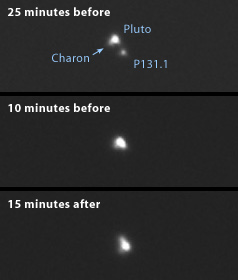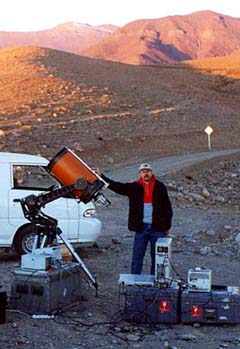
The view of Earth from Pluto's perspective during the little planet's two occultations in mid-2002. July's track over South America barely missed several large observatories, while the August event could be viewed by large telescopes in Hawaii, California, and Arizona.
S&T: Steven Simpson (source: J. Elliot/MIT).
The last two months have been good ones for Plutophiles. In July a U.S. Senate subcommittee fortified NASA's budget with $105 million to continue work on the New Horizons mission, which could be launched toward the distant planet as soon as 2006. And during the past five weeks telescopes have captured the passage of Pluto in front of not one, but two faint stars. Although analysis of the stars' brief disappearances has only begun, it is already clear that observing teams from the United States and Europe have come to very different conclusions about the state of Pluto's atmosphere.
During the first event, on July 20th (Universal Time), Pluto's shadow crossed South America and, unfortunately, barely missed passing over a string of major observatories in the Andes. The only "hits" came from astronomers with portable setups: Marc Buie and Oscar Saa used a 14-inch Celestron and a CCD camera near the small Chilean town of Mamiña, while Francois Colas had a CCD-equipped Meade LX200 12-inch telescope a little farther north near Arica. According to Bruno Sicardy, who coordinated the European effort, seven other ground teams in Chile, Ecuador, Peru, and Venezuela were either clouded out or experienced technical difficulties. Fortunes improved for the August 21st occultation, as the broad path passed over observatories in Hawaii and the Far West.

For the second time in a five-week span, Pluto drifted across a faint star in southern Ophiuchus. This series, taken on August 21st (Universal Time) with the University of Hawaii's 2.2-meter telescope on Mauna Kea, shows the motion of Pluto and Charon, its moon, with respect to the 16th-magnitude star known as P131.1.
Courtesy Jay M. Pasachoff, Bryce Babcock, David Ticehurst, and Steven Souza (Williams College).
Pluto's atmosphere was discovered during just such an event 14 years ago, making its existence known when a star winked off and on gradually (not abruptly) as the planet passed directly in front of it from Earth's perspective. But no other occultations by Pluto have been observed since because the planet's disk is so small (0.1 arcsecond across) that head-on encounters with stars are rare. The 1988 occultation, recorded in Australia and New Zealand, and over the South Pacific by the now-mothballed Kuiper Airborne Observatory, demonstrated that Pluto's atmosphere has a surface pressure only 1/100,000 that of Earth. But sharp kinks in the light curves also revealed that the lower atmosphere contains either a layer of haze or a temperature-inversion layer.
In planning for this year's events, astronomers believed they could end years of speculation about these disparate models, as well as whether Pluto's wisps of nitrogen, methane, and carbon monoxide are freezing out onto the surface as the planet slips farther from the Sun. (Pluto passed the perihelion point of its 248-year-long orbit in 1989.) "We've seen that the atmosphere is really changing," says James L. Elliot, who coordinated the U.S. observing effort. "It's not like it was in 1988 — that's firm." He notes that at the highest levels the gas is now 10° to 30° colder than the 110° Kelvin found previously, and the light curve's distinctive kink is gone.

Marc Buie (Lowell Observatory) ventured to a remote location in northern Chile with this Celestron 14 telescope and hundreds of pounds of other gear. There he recorded Pluto's occultation of an obscure 12th-magnitude star known as P126A on the night of July 19–20, 2002.
Courtesy Oscar Saa (Cerro Tololo Interamerican Observatory).
At the same time, Buie adds, there are hints that gas closest to the ground, near 40° K in past years, has gotten warmer — and by implication so has the surface. Buie speculates that even though Pluto is moving away from the Sun, its surface may have recently become darker. Perhaps its patchy dark regions are now facing the Sun more directly, and thus absorbing extra energy, or perhaps a frost layer near the north pole (now bathed in more direct sunlight) is vaporizing to reveal a darker underlying surface.
But all this talk of "dramatic changes" in the atmosphere is being met with skepticism by Sicardy. "We have no firm evidence for a cooldown of the upper atmosphere," he counters. Moreover, the diagnostic kink can be seen in his team's light curves from both occultations, though not as conspicuously as it was 14 years ago. "We don't see much change, though there are some differences."
Both teams agree that this confusing situation would be much clearer if only they knew Pluto's true diameter, which is near 2,300 km but still uncertain by several tens of kilometers. There's a chance that one of the tracings from August 21st will probe all the way to the surface, which, Buie notes, would provide a "real breakthrough." Also, since Elliot's team recorded the event in many visible and infrared wavelengths, it should be possible to distinguish between the "haze-layer" and "inversion-layer" models. "Stay tuned," Buie says: another promising occultation may be observable on November 7th.
 0
0
Comments
You must be logged in to post a comment.